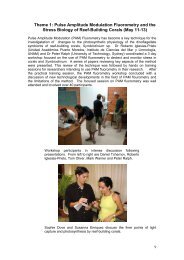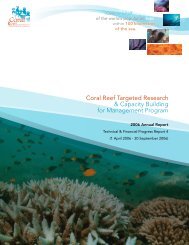Coral Disease Handbook - Coral Reef Targeted Research
Coral Disease Handbook - Coral Reef Targeted Research
Coral Disease Handbook - Coral Reef Targeted Research
You also want an ePaper? Increase the reach of your titles
YUMPU automatically turns print PDFs into web optimized ePapers that Google loves.
A <strong>Coral</strong> <strong>Disease</strong> <strong>Handbook</strong>:Guidelines for Assessment, Monitoring and Management1ForewordOur research careers began in Discovery Bay, Jamaica, in the mid 1970s, where we both studiedthe behavior of coral reef organisms, rather than the corals themselves. At that time, living coralcovered 70 percent of the bottom, and no one worried about the long term persistence of the reefs,even though the reefs were clearly impacted by people via severe overfishing. Quite simply, we tookthe reefs for granted.That sunny confidence turned out to be totally unfounded. In 1980, Hurricane Allen, a categoryfive storm, struck and turned much of the reef into a rubble ground. However, reefs routinely get hitby hurricanes and typhoons, so they should have recovered. But in 1982 the sea urchin Diademaantillarum was decimated by an as yet unidentified pathogen, and losing this last remaining majorgrazer contributed to the overgrowth of corals by seaweeds throughout the region. By 1995,coral cover stood at less than 10 percent.But the loss of grazers was not the only thing happening to these reefs. A more subtle and gradualbut no less important killer was also taking its toll – the white band disease of the branching staghornand elkhorn corals. These two species used to be so common that as students we were taught aboutthe “Acropora cervicornis zone” and the “Acropora palmata zone”. Now both species are listed asendangered under the Endangered Species Act, having lost over 90 percent of their numbers in theensuing decades. Like the elms and chestnuts of US forests, they have largely vanished due to disease.And they are not alone – white plague, yellow band, black band, and many others have since beendocumented as major reef killers, not only in the Caribbean but in the Pacific as well. For most of thesediseases we still do not know the causative agent – nor the extent to which pollution and increasedsea surface temperatures may be contributing to disease outbreaks or affecting the ability of corals torecover from infections. Yet progress is being made, and simply reliably recognizing and documentingthese syndromes and their patterns of infection are important first steps in addressing this problem.This handbook makes it much easier to do just that. Designed for managers, it outlines proceduresfor describing signs, measuring disease impacts, monitoring disease outbreaks, assessing causes,and managing reefs to minimize losses due to disease. As the authors note, information and expertiseon coral disease are inadequate relative to the scale of the problem. This handbook helps managersnot only to document and manage disease on the reefs they are responsible for, but also allows themto contribute to our scientific understanding of this grave threat.Nancy KnowltonSant Chair in Marine ScienceNational Museum of Natural HistorySmithsonian InstitutionMarea HatziolosEnvironment DepartmentThe World Bank5 5








